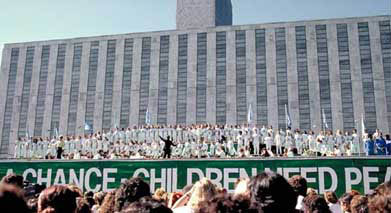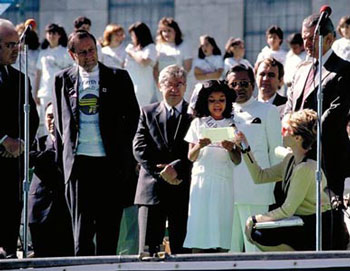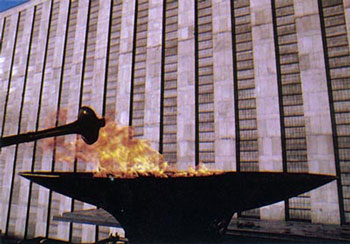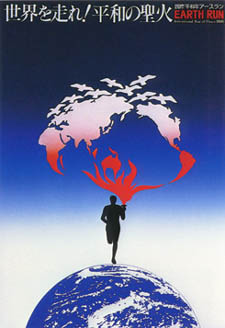THE DREAM ALIVE IN THE WORLD

So how do you transport a multicultural group of people, a live flame and torches through a new country almost every day? How do you successfully guide people with limited experience to organize several hundred community ceremonies and millions of people? How does one go about convincing dozens of heads of state to participate? How do you persuade airlines to go against their regulations and allow a live flame on board? The logistical challenges were unending. It was like mounting an expedition to scale Everest for the first time meets organizing the Olympic Opening Ceremony!
While these challenges were being confronted, a most daunting one still laid ahead: attracting the several million dollars of financing needed to make all this happen. I needed to provide assurances to the sponsors about our team’s ability to pull off an event of immense global magnitude that had never been done before. While I had secured seed capital to pay some staff, with six months left to go there was still no major sponsorship. As the seed funding and Gail’s and my financial resources were dwindling, a growing realization was occurring to me. We were persuading people all over the world to invest their time and hope, in some cases at the cost of economic hardship, and I might not be able to raise the money to actually do it. If I couldn’t raise the money, I would be an outcast almost everywhere in the world. Our Japanese organizer Atsuo Shiga, described the situation: “How far can one run on an empty stomach?”
For about a year, we had been having discussions with the United Nations Children’s Fund (UNICEF) about a partnership. As our international organization grew and momentum built their interest was peaked. It culminated in a meeting with Jim Grant, UNICEF’s visionary leader, who agreed to have his organization become an in-kind sponsor, using the event to celebrate their 40th anniversary. They would also be a recipient of any funds raised. In return, they would provide active support reaching out to heads of state through their international network, office space in their Manhattan headquarters, and state-of-the-art communication infrastructure. In the mid 1980s, this meant an in-house telex machine to receive cable messages. There were no fax machines or e-mail. Our team moved into wonderful new digs overlooking Manhattan’s East River. We were motivated to keep running on an empty stomach.
Soon the media caught wind of the audacity and significance of this initiative. Stories began appearing in the New York Times and on the major TV networks for what was now being called the First Earth Run. One team member, Hal Uplinger, who had helped produce the mega rock concert fund raiser for famine relief in Africa, Live Aid, used his contacts at ABC Television to bring them on as the media sponsor. They committed to providing coverage of the torch’s 12 week passage around-the-world every Wednesday morning on Good Morning America.
Then the political leadership support began falling into place, including US President Ronald Reagan, Soviet Union’s President Mikhail Gorbachev, and China’s President Li Xiannan. As the momentum built, requests started coming from many heads of state asking that the flame go through their country. One of the most meaningful requests came from King Birendra of Nepal. He wished the torch of peace to light an eternal flame he would erect at the pilgrimage birthplace of the Buddha in Lumbini. He said he wanted the millions of Buddhist pilgrims who come to Lumbini to be inspired by this act of peace building. The mythic power of the dream was generating a magic that was captivating all who heard it.
A member of the core team, Brooke Newell, a Vice President of the large multi-national Chase Manhattan Bank, had begun soliciting her company as sponsors from the inception of this idea. As the senior leadership heard of the growing support and momentum that was building, they became interested in sponsorship. They had come to the conclusion as described in a memo that, “this is one of the truly extraordinary activities of our time and is an unparalleled opportunity for our company.” Soon we were negotiating in earnest for a multi-million dollar sponsorship. The only issues were how much they would pay and how they would promote it. Needless to say, this news gave everyone on the organizing team a collective sigh of relief.
Then one day about three months before the event, Brooke requested a meeting with me. We met frequently about the negotiations with Chase, but this day Brooke had an ominous look about her. She got right to it. After a hard-headed analysis at the highest levels of the organization, Chase decided to pull back from sponsorship. They determined this was too risky an undertaking. So many things could go wrong. They ticked them off one after the other. Without consistently professional crowd control the runners, spectators and team were at risk of bodily harm or even death. It was such a high-profile event that it could easily be hijacked by a fringe organization for their political purposes. The level of organization was uneven and in any number of countries the event could fall on its face with minimal participation. If it was used as a propaganda event by communist dictators it would reflect poorly on the company. The overall assessment was it was just way too risky a venture for them. They were unwilling to go forward.
It was definitely my moment of truth. What should I do? Should I thank my amazing team for their efforts and faith in me as a leader, but tell them there just wasn’t enough time to find another sponsor? That we needed to call this off before more expectations were raised? I was in emotional turmoil. So many years of work. Such an extraordinary opportunity to make a difference. We were so, so close.
I sought support and counsel from my dear wife Gail, who had been there 110% at every step of the journey. She held me and advised that I pray for guidance and sleep on it. I followed her advise and when I awakened the next day, I was clear.
I called my core team of about 25 together in our United Nations offices. They assembled in the only location where everyone could fit – a corridor between our tightly packed offices. Calmly, but with my heart in my throat, I told them: “Chase Manhattan Bank has decided to pull out as a sponsor. We have no other prospects at the moment, as Chase had wished to be the sole sponsor. It would be extremely hard to find a multi-million dollar sponsorship on this short notice. Everyone’s faith and dedication has brought us to this point and now we are all being asked where we stand. I have decided to go forward and I ask each of you to think hard about what you want to do. I will understand if you aren’t willing or able to hang in any longer. After all, most of you have not been paid, and those who have, receive a survival level salary. Our workload is relentless – 10 to 12 hour days. For every logistical and political challenge we solve, two new ones appear. In spite of this major setback, I will do whatever it takes to find another source of funding.”
The team did not hesitate. They unanimously decided to go forward. They determined they would keep running on an empty stomach.
I decided my best chance was to speak to UNICEF’s Executive Director, Jim Grant and ask for his financial support. From several communications, I knew Jim had become a real partner. He told me he was in awe of the response this was getting from usually reticent political leaders all over the world. He said, that although he was getting some resistance from his country directors, the positive association of people and political leaders around the world toward UNICEF would make their work much easier in the future. He also hoped it would assist their fund raising efforts both through the event and in the future by the increased visibility. But his bottom line was this was the right thing to do for the world and that was why he was putting his organization behind it.
I arranged a meeting with Jim the next day to explain what had happened. By the time I arrived, Jim had already heard that Chase had pulled out. When I asked him to consider funding the whole thing, he was ready with an answer. He said, “We will make it happen!” I could not hold back my tears of relief and joy. Jim told his organization to find the money in the budget and UNICEF became the global underwriter and sole sponsor. A better sponsor for a global humanitarian mission of this magnitude could not have been found. This moment marked a phenomenon that had become a hallmark: each time we were faced with a seemingly insurmountable challenge, help came. All concluded, this dream had grace!
FIRST EARTH RUN ON GOOD MORNING AMERICA
FIRST EARTH RUN: UN OPENING CEREMONY REMARKS

UNITED STATES CONGRESSIONAL RESOLUTION

FIRST EARTH RUN MUSIC

This music was inspired by the First Earth Run. It contains musical offerings by a number of artists who call upon us to envision a planet of peace, cooperation, global unity and our responsibility to create it.
1. Earth Run Anthem: Amanda George, James Papoulis – 2:20
2. Earth Run Anthem (instrumental): James Papoulis – 2:19
3. Run for the Life of the World: Julie Stafford, Dave Nolan – 3:50
4. Carry the Flame: Randy Bishop, Lisa C. Cohen – 4:04
5. Give the World a Chance: M. Tewksbury, P. Spiller – 4:38
5. Earth Run: Lee Ritenour – 4:32
7. D’Une Rive A L’Autre: Michel Jonasz – 4:04
8. Celebrate Life Around the World: Joyce, Ray – 1:39
9. Run for My Life: Cavarier – 4:09
10. We Love You First Earth Run: Franko – 5:07
11. Pass Me the Torch of Peace: Omar Ken – 5:13
FIRST EARTH RUN POSTER COMPETITION

As part for the First earth Run, there was a national competition in Japan to create posters celebrating this epic event to further peace in the world. It inspired a great outpouring of creativity and vision. What follows are the wining posters and the runners-up.
